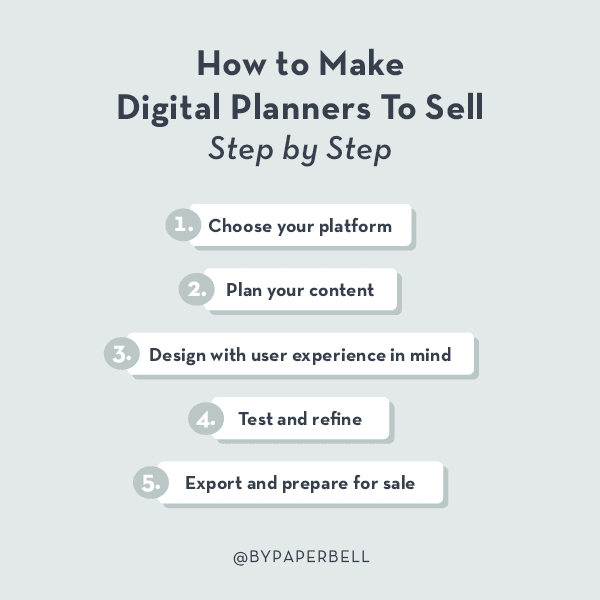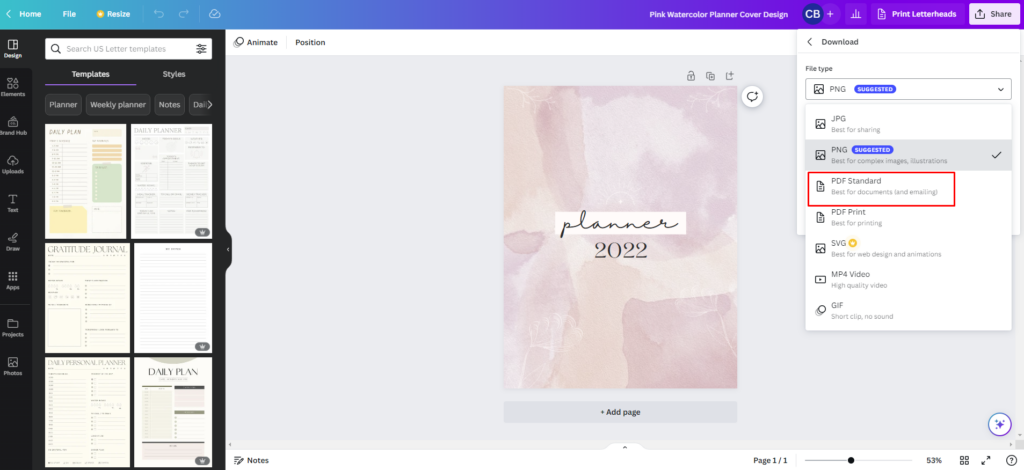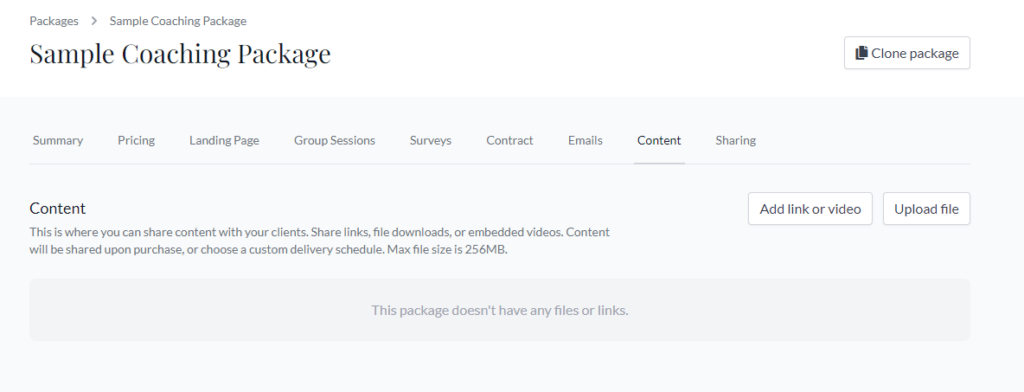Are you looking to create a digital planner to sell but unsure where to start?
As an alternative to paper planners, digital versions have become increasingly popular as they are more convenient and customizable.
To help you create a digital planner to sell, I’ll guide you through making one from scratch.
Not only that, but we’ll also discuss how you can turn your passion for planning into a profitable online business by selling these digital products.
Here’s what you’ll learn in this comprehensive guide on how to create a digital planner to sell:
- What is a digital planner?
- How to create a digital planner step-by-step.
- How to sell digital planners.
- Tips for marketing and selling your finished product.
What is a Digital Planner?
A digital planner is an electronic version of a traditional paper planner designed to help users organize their lives and achieve their goals.
How can it help you as a life coach?
Creating digital planners can enhance your coaching practice by offering extra benefits to your clients and generating additional income for your business. It can be a perk for an existing coaching package or a freebie as part of your lead generation.
Benefits of Using Digital Planners
Though the traditional planner might still have an appeal for certain journaling and reflection exercises, most coaching tools are moving digital.
Here are some of the several advantages that digital planners offer:
- Eco-friendly: By going paperless, you’re contributing to reducing waste and helping protect the environment.
- Accessibility: Digital planners can be accessed from any device with internet access, making it easy for clients to stay organized and share their notes with you.
- Customization: Online tools like Adobe InDesign and Canva make it much easier to create custom designs from simple templates. You can create different layouts and content tailored to each client’s needs.
- Integration with other tools: Many digital planning apps allow users to sync their calendars or task lists with popular productivity tools such as Google Calendar or Trello, keeping everything in one place for better organization.
Examples of Digital Planners for Life Coaches
Need some digital planner ideas? Check out these popular examples:

- The best planners by the GoodNotes blog: Here’s a list of various planner styles and formats that you can use as inspiration for designing your own.
- Cheqmark: This free tool suggests a monthly planner template that is easy to use and can be printed out.
- Passion Planner Digital Edition: It’s a versatile digital planning system offering many features. It includes yearly overviews, monthly spreads, and weekly spreads, allowing for customization according to individual needs.
- Amanda Rach Lee Doodle Planner: This unique and creative planner seamlessly integrates productivity and mindfulness. Besides the usual task organization framework, it offers doodling exercises for stress management and self-care.
- Year Compass: This is a popular yearly reflection booklet used by journaling fans worldwide. You can download it for free to flip through the pages and get inspiration for your planner.
Now that you have a better understanding of what digital planners look like and how they can benefit your coaching practice, let’s dive into creating one to sell.
How to Make Your Own Planner to Sell Step by Step

Creating a digital planner as an additional revenue stream for your coaching business is easier than you might think. For example, Shanice on Biz is a content creator and self-published author who made $1200 selling digital planners on Etsy.
With the right tools and some creativity, you’ll have a valuable resource that clients will love! Here are the steps on how to make a planner to sell.
Step 1: Choose your platform
The first step is to decide which platform you’ll want to sell your planner on. Each of them offers some unique features, so consider which one you prefer to work with and where your design skill level is at.
Here are a few popular design tools you can choose from:
- Canva: Canva is super easy to navigate even if you’ve never designed anything. It has thousands of templates and free design elements that you can drag and drop to put together your new planner.
- Adobe InDesign: Adobe has way more features than Canva and it’s generally preferred by professional designers. It might take some learning to use if this is your first time. Their plans start at $22.99 per month.
- Affinity Publisher: Affinity offers a great balance between functionality and ease. It costs a one-time fee of $69.99 for either the Windows or macOS version, you can get the entire suite on all platforms for $164.99 with the Universal Licence.
- Procreate: If you really want to get creative and start from scratch (or rather, sketch), you can use a digital sketch program like Procreate for a one-time fee of $12.99.
- GoodNotes: This is another digital sketch program with a free trial that lets you create three notebooks.
- Envato Elements: Envato Elements stands out as the platform that offers unlimited downloads of millions of digital assets for all your design and creative projects. The individual plan starts at $16.50 per month, but they also offer special prices for teams, students and teachers.
Another option is to purchase pre-made digital planner templates from creative marketplaces like Creative Market or Etsy. You can then create a custom planner with your brand elements and structure in the design app they were created in.
Our suggestion? Start with Canva! They have several premade digital planner templates you can use instead of starting your design entirely from scratch.

A lot of their templates are free and pretty decent, but if you really fall in love with one of their Pro designs, you can also sign up for Canva Pro for $14.99.
Step 2: Plan Your Content
As with all creative work, it’s best to create an outline for your planner before you jump into writing and designing it.
Here are a few elements that make great planners for coaching clients:
- Goal-Setting Pages: Include some exercises that help your clients define clear and measurable goals for themselves.
- Progress Tracker: Besides setting new goals, planners are also great for checking in on objectives already set. This could be a chart that visually represents new milestones achieved or a simple weekly check in.
- Habit Trackers: Building habits is all about consistency. Inspire your clients to stick to positive habits with a simple daily planner or weekly tick-off.
- Reflection prompts: This is where your coaching questions and journaling prompts go with plenty of blank space for your client to reflect on them.
- Mindfulness and Wellness Section: Your mindfulness exercises, journaling prompts, and wellness activities go here. This could blend well-being with productivity in your planner.
- Challenges and Rewards: Create a system for coaching clients where they can set challenges for themselves and define how they’ll reward themselves after achieving them.
- Affirmations: You can sprinkle positive quotes and affirmations throughout your planner as a nice added touch, or provide one as a journaling prompt your clients can reflect on.
- Resource Library: This is the section where your clients can save helpful resources (books, articles, videos, or courses) related to their personal development goals.
- Skill Development Tracker: If your client is focusing on getting better in a particular skill, they can check-in about their progress here. The more measurable it is, the better.
- Gratitude Journal: Gratitude exercises are one of the simplest and most effective ways your clients can improve their well-being. Plus, it’s so easy to add them to your digital planner or add an option for printable planners.
- Weekly and Monthly Reviews: Include structured pages to help clients assess what worked well for them and what could be improved so they can make adjustments.
Think about the needs of your audience – what would they find most helpful?
What are their biggest pain points, and how can you address those in a digital planner?
Design a personal planner that supports their journey and provides valuable resources for their personal development.
You can also download our template pack if you want to spruce up your website or coaching package before creating your digital planner.

Step 3: Design With User Experience in Mind
Visually appealing design is always a big hit. It plays a vital role in ensuring that your clients will actually use and value your planner.
To achieve this, it’s important to:
- Maintain consistency in fonts and colors throughout the planner as it creates a cohesive and aesthetically pleasing look.
- Make sure to incorporate hyperlinks or clickable tabs within the document, allowing for easy navigation and accessibility to different sections or pages of the planner.
- Include customizable and versatile page templates into your design process so that your users can personalize the planner to their specific needs and preferences.
Aesthetic design will help your digital planner sell, but it’s functionality that will make sure your clients will persistently use it.
Step 4: Test and Refine
Before launching your digital planner for sale, test it out. You can go through it yourself, ask a friend for their opinion, or give away a free sample to a client in exchange for their feedback.
This will help ensure that everything works as intended and allows you to make any necessary adjustments before putting it on the market.
Check for any broken links, formatting errors, or difficulties accessing different planner sections.
You can also gather feedback on the overall user experience, including the clarity of instructions, ease of navigation, and visual appeal.
Step 5: Export and Prepare for Sale
Once you are satisfied with the design and functionality, export the planner in a suitable format for tablets or computers, such as PDF.
If you’re using Canva, you can navigate to Share > Download > PDF Standard:

Ensure the file size is optimized for easy download without compromising the planner’s quality.
To sell your digital planner effectively through platforms like Paperbell, create an eye-catching product image on your shop landing page.
You can showcase its features and an engaging description highlighting how this resource can benefit potential buyers.
Remember – marketing is key.
In just five simple steps, you can create a valuable tool that adds value to your coaching business and provides an additional revenue source.
How to Sell Digital Planners
It’s time to hit the stores. Here’s how you can make money selling digital planners.
1. Choose a Platform for Selling
There are various online platforms that let you sell your digital planner. A few examples are:
- Etsy: A marketplace of handmade, vintage, and unique products. Sellers can connect with a community of art and craft enthusiasts.
- Sellfy: Enables creators to sell digital products directly to their audience through customizable online stores.
- Podia: An all-in-one platform for digital product creators combining tools for selling online courses, memberships, and digital downloads.
- Payhip: A digital product marketplace allowing creators to set up an online store with discount codes and affiliate marketing.
- SendOwl: A streamlined online store including automated delivery, secure payment processing, and integration with various third-party tools.
- Gumroad: A simple platform for selling digital and physical products directly to fans, focusing on supporting artists, writers, and other creatives in building a sustainable income.
But did you know that you can also use Paperbell to sell your digital planners and other digital products?
This way, you can skip signing up for yet another platform and paying a seller feed altogether and instead keep everything related to your coaching business in one place.
Once you set up your coaching package, you can add any coaching materials, including digital planners.
You can upload both video and PDF content via a link or a file:

It’s as simple as that. Instead of using a separate platform, you can keep your digital planner where you sell your coaching packages. More importantly, you don’t have to pay another tool to host your digital planners.
2. Set up Payment Processing
For digital planners to sell, you need to provide a way for clients to pay you online.
Choose a secure and easy payment processor that customers trust. You’d be surprised how often online products fail because of this crucial last step of the marketing funnel.
The two most widely used and trusted payment processors are Stripe and PayPal. Luckily, if you’re using Paparbell, they are already integrated with your packages.
After you describe your packages, Paperbell will automatically create a store page where customers can read all the information they need, sign up, and send you the payment.
3. Price Your Product Strategically
Research other planners and similar digital products in the market so you can set a competitive price for yours. Besides market research, consider factors such as:
- Production costs (design fees): Consider the expenses incurred in creating your digital planner, such as design fees, software subscriptions, and any other production costs.
- Perceived value by potential buyers: Assess the value it provides to potential buyers and how it stands out from competitors.
- Target audience: Consider their purchasing power and what they might be willing to pay for a high-quality digital planner that meets their specific requirements.
4. Promote Your Digital Planner
Once your digital planner is available for purchase, it’s time to spread the word. Here are some effective ways to promote your product:
- Email marketing: If you have an existing email list of clients or subscribers, send out a newsletter announcing the launch of your new digital planner and any special offers or discounts.
- Social media: Share posts about your digital planner on platforms like Facebook, Instagram, Pinterest, and LinkedIn. Create eye-catching graphics using tools like Canva to grab attention.
- Collaborate with influencers: Partner with life coaches or other professionals in related fields who can help promote your product through their networks.
- Content marketing: Write blog posts discussing how a digital planner can benefit users and provide tips on maximizing its use. Include links back to where they can purchase yours within these articles.
- Be a guest on podcasts: You can share your expertise and mention how you use your digital planner to help coaching clients get better results.
- Run ads to your digital planner: Set up Google or Facebook ads promoting your planners. This strategy takes some advertising budget, so consider how much you want to invest in it while still making sure you make a profit.
5. Track Your Sales Performance
When you start selling, monitor the performance of your digital planner by tracking metrics such as
- Number of sales
- Revenue generated
- Traffic sources
- Conversion rates
Through this, you can identify areas that need improvement to optimize your marketing efforts moving forward.
Don’t forget to read any customer reviews and incorporate useful feedback from your first few buyers.
Incorporating a Digital Planner Into Your Coaching Practice
To incorporate a digital planner into your coaching practice effectively, consider these tips:
- Identify client needs: Focus on common challenges or niche-specific issues relevant to your clients, such as time management or goal-setting strategies.
- Provide resources and tools: Offer helpful materials like worksheets, templates, or links to articles that complement your coaching sessions.
- Personalize the planner: Customize it with your branding elements and add personal touches like your own motivational quotes and affirmations tailored to your niche.
For instance, if you specialize in helping entrepreneurs manage time effectively, create a digital planner with:
- Goal-setting sections
- Customized weekly scheduling templates for entrepreneurs’ unique needs (e.g., networking events)
- Curated productivity hacks from successful business owners
If you can provide valuable resources alongside your one-on-one coaching sessions or group programs, you’re not only offering additional support but also positioning yourself as an expert in your niche.
FAQs About Digital Planners
How Do I Create My Own Digital Planner Business?
To start your own digital planner business, begin by designing your templates using a design program like Canva, Adobe InDesign, or Affinity Publisher. Once you have created your pages, upload them to Paperbell as part of a coaching package.
Can I Make Passive Income from Selling Digital Planners?
Yes, you can make money selling digital planners. Selling planners can be an excellent source of passive income once they are uploaded and available for purchase online. With platforms like Paperbell handling all the tricky moving parts, it’s easier than ever before to start earning money through this avenue.
Can You Sell a Digital Planner Made on Canva?
Yes, you can create and sell a digital planner designed using Canva. However, make sure that all the design elements you use have a commercial license, permitting you to sell the planner containing them.
How to Make a Planner to Sell on Etsy?
To make a digital planner for Etsy, follow the steps in this guide outlined above. Consider adding your digital planners to your coaching packages with Paperbell to avoid transaction fees and running your business processes on multiple platforms.
Start Creating Planners to Grow Your Coaching Business
So here’s everything you need to know about creating a digital planner to sell. We hope this will turn out to be a fulfilling creative project for you that will help your clients and your coaching business grow.
To keep your digital planners and coaching packages all on the same platform, consider running your coaching business on Paperbell.
Try it for yourself by claiming your free account today.

Editor’s Note: This post was originally published in June 2023 and has been updated in March 2025 to add new information and examples.









